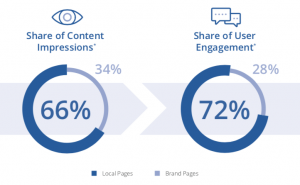
Trust at work is the key to engagement, collaboration, and ultimately, an organization’s ability to achieve its goals. Trust in leadership is particularly important in enabling an organization to perform to its potential. In fact, it’s the relationship between managers and employees that is most correlated with higher levels of trust and performance. However, because organizations have become larger, more complex and more siloed, and because employee expectations are changing, the trust gap between employees and leadership is growing. There are several factors that underpin building improved trust, but perhaps most important is transparent communications between leaders and employees.
Defining trust at work
The Human Capital Institute (HCI) defines trust as the willingness to put oneself at risk based on another individual’s actions. In the context of the workplace, organizational trust is based on:
- The belief that we have shared purpose, goals and objectives. An individual is more likely to take personal risk if they believe others will act in a way that achieves a shared purpose.
- Demonstrating that we consistently do the right thing and act with values. How we achieve those objectives is equally important – it can’t come at the cost of others, customers, the environment, society or shareholders.
- Showing that we can be counted on to keep our commitments. A culture of honesty, transparency and openness makes it easier for employees to feel safe also being open and transparent.
Trust is correlated with strong results
From the Building Trust 2013: Workforce Trends Defining High Performance report from HCI, high-performing organizations (defined as organizations experiencing greater than 5% YoY growth) had much higher levels of confidence in leadership, trust and collaboration. Gallup’s State of the Global Workforce report found that a solid foundation of trust can lead to increased productivity, profitability and lower turnover. Perhaps the most compelling evidence comes from Great Place to Work. Each year they conduct the world’s largest workplace study, annually surveying over 7,200 organizations representing 11 million employees in 52 countries on trust. In their report, The Business Case for A High Trust Culture, they found that companies with trust based cultures typically enjoy:
- Stock market returns approximately two to three times greater than the market average
- Turnover rates that are approximately 50 percent lower than industry competitors
- Increased levels of innovation, customer and patient satisfaction, employee engagement, organizational agility, and more
Trust is key to productivity
Having trust is critical to great execution within a team. Without trust, people over-function because they don’t believe others will deliver what they’re dependant on for their own success. They check-in more than they need to, they build contingencies into their own work, they attempt to do others work themselves and ultimately they become less engaged.
Trust in leadership and engagement
It was another era when leaders could expect employees to simply follow through on what was asked of them and employees counted on the fact that as long as they did this, they had employment for life. The industrial economy has given way to the creative economy and the purpose economy. With work being such a significant part of our lives and sense of worth and meaning, people want a deeper connection to their work and the people they work with. According to Building Trust 2013, more than 80% of those surveyed believe that being effective in their work requires a high degree of trust in their leaders. Another survey highlighted that 69% of employees believe it’s more important to trust their boss today than in the past.
Trust and advocacy
Employees that have trust in their organization are a tremendous asset and employees that don’t are a liability. According to the Edelman survey on trust, employees are the most credible voices on multiple topics including the company’s work environment, integrity, innovation and business practices. If you build trust with your employees, they’ll say good things about you. And when they do, consumers will believe them. Based on what employees say, there is a strong correlation to how consumers will act. Choices to buy or not buy, pay more, buy or sell shares, and criticize or recommend are significantly influenced by with the company is trusted or not trusted.
The Trust Gap
Unfortunately, Edelman found that employees have grown more distrusting and skeptical of institutions and leadership. Nearly one in three employees don’t trust their employer. And more than two thirds feel that CEOs are too focused on short-term performance. Forum, a leadership development company found that 91% of employees felt it was important to have a high trust relationship with their boss, while only 48% of bosses did. As a result, employees are far less likely to say positive things about the company they work for.
Building Trust at Work
To simplify all the advice we read through and what we have learnt ourselves, we’ve tried to distill down the different actions for building trust into a broader theme. Central to trust is open, transparent and honest communication between leadership and employees.
In Forum’s survey on the trust gap, they found that employees and leaders agreed on this. In contrasting leader and employee responses, they found that both agreed trust could be improved through: encouraging employees to offer ideas and suggestions; listening to employees and understanding their concerns; and following through on commitments.
From one of Edelman’s earlier Trust Barometer studies, one of the individuals closely involved in the development of the study surmised the need for communication.
Today’s management must hold true to some basic tenets: authentic communication, relationship-building methods, and a communication style that affords open, transparent, ongoing discussion, which allows people to drive business strategy, and, most importantly, to voice opinions and suggestions that ultimately affect performance and business outcomes.
A good example of this is the story of an unnamed professional-services firm struggling to meet revenue targets. Rather than do things the old-fashioned way and chart a course of action themselves, management instead sought help from employees.
They did this by showing employees a list of all possible changes and gathering feedback. And it worked. This bold act of transparency through information disclosure and feedback-gathering in turn generated buy-in for the steps needed to get the company back on track. And, to boot, it increased employees’ willingness to execute the plan.
The result? The company made the changes without needing to lay anyone off. Win-win.
Business & Finance Articles on Business 2 Community(107)
Report Post







